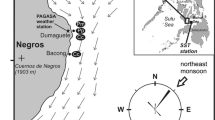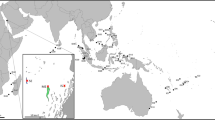Abstract
Reproduction of tropical species beyond their geographic range associated with ocean warming is regarded as the key indicator of a range shift. However, the lack of historical breeding records poses challenges for detecting distinct range shifts of tropical fishes. To obtain baseline data of the current status of the occurrence and breeding activity of tropical pomacentrid and apogonid fishes in ocean warming hotspots of temperate reefs (Kochi and Wakayama, 33°N) of Japan, we conducted a two-year underwater visual survey and synthesized those data with recently published information. By combining data from the present as well as past studies, the results confirmed the occurrence of 52 pomacentrid and 34 apogonid species, whereas breeding activity was confirmed for 19 and 16 species, respectively. Species richness and abundance of recruitment periphery and breeding active species were high at the warmer site adjacent to the Kuroshio Current. Most observed species were found beyond their known geographic range. Some species showing active breeding were widespread tropical fishes (e.g., Amphiprion clarkii, Pomacentrus coelestis and Apogon notatus) and probably have established breeding populations irrespective of recent global warming. The winter sea water temperature around the study sites will continue to rise, increasing by >2 °C by the end of the century; therefore, our results are highly relevant and represent the first step to elucidate the potential range extension of tropical fishes into temperate reefs with climate change.





Similar content being viewed by others
References
Asoh K (2005) Gonadal development and diandric protogyny in two populations of Dascyllus reticulates from Madang, Papua New Guinea. J Fish Biol 66:1127–1148
Bates AE, Pecl GT, Frusher S, Hobday AJ et al (2014) Defining and observing stages of climate-mediated range shifts in marine systems. Glob Environ Chang 26:27–38
Beck HJ, Feary DA, Fowler AM, Madin EMP, Booth DJ (2016a) Temperate predators and seasonal water temperatures impact feeding of a range expanding tropical fish. Mar Biol. doi:10.1007/s00227-016-2844-8
Beck HJ, Feary DA, Nakamura Y, Booth DJ (2016b) Wave-sheltered embayments are recruitment hotspots for tropical fishes on temperate reefs. Mar Ecol Prog Ser 546:197–212
Bell LJ (1976) Notes on the nesting success and fecundity of the anemonefish Amphiprion clarkii at Miyake-jima, Japan. Jpn J Ichtyol 22:207–211
Bell LJ, Moyer JT, Numachi K (1982) Morphological and genetic variation in Japanese populations of the anemonefish Amphiprion clarkii. Mar Biol 72:99–108
Booth DJ, Figueira WF, Gregson MA, Brown GL, Beretta G (2007) Occurrence of tropical fishes in temperate southeastern Australia: role of the east Australian current. Estuar Coast Shelf Sci 72:102–114
Booth DJ, Bond N, Macreadie P (2011) Detecting range shifts among Australian fishes in response to climate change. Mar Freshw Res 62:1027–1042
Connolly SR, Bellwood DR, Hughes TP (2003) Indo-Pacific biodiversity of coral reefs: deviations from a mid-domain model. Ecology 84:2178–2190
Feary DA, Pratchett M, Emslie M, Fowler A, Figueira W, Luiz OJ, Nakamura Y, Booth DJ (2014) Latitudinal shifts in coral reef fishes: why some species do and others don’t shift. Fish Fish 15:593–615
Figueira WF, Booth DJ (2010) Increasing ocean temperature allow tropical fishes to survive overwinter in temperate waters. Glob Chang Biol 16:506–516
Figueira WF, Biro P, Booth D, Valenzuela V (2009) Performance of tropical fish recruiting to temperate habitats: role of ambient temperature and implications of climate change. Mar Ecol Prog Ser 384:231–239
Fodrie FJ, Heck KL Jr, Powers SP, Graham WM, Robinson KL (2010) Climate-related, decadal-scale assemblage changes of seagrass-associated fishes in the northern Gulf of Mexico. Glob Chang Biol 16:48–59
Froese R, Pauly D (eds) (2012) FishBase. World Wide Web electronic publication Accessed December 2012Available: http://www.fishbase.org
Hirata T, Yamakawa T, Iwata A, Manabe S, Hiramatsu W, Ohnishi N (1996) Fish fauna of Kashiwa-jima Island, Kochi Prefecture, Japan. Bull Mar Sci Fish, Kochi Univ 16:1–177 (in Japanese with English abstract).
Hirata T, Yamaoka K, Kanda M, Hirata S (2001) Atlas of fishes in life mode. In: Nakabo T, Machida Y, Yamaoka K, Nishida K (eds) Fishes of the Kuroshio current. Japan. Osaka Aquarium KAIYUKAN, Osaka, pp 42–111 (in Japanese)
Hirata T, Oguri S, Hirata S, Fukami H, Nakamura Y, Yamaoka K (2011) Seasonal changes in fish assemblages in an area of hermatypic corals in Yokonami, Tosa Bay, Japan. Jpn J Ichthyol 58:49–64 (in Japanese with English abstract).
IPCC (2014) Climate Change 2014. Core writing team, Pachauri RK, Meyer LA (eds). Cambridge University Press, Cambridge
Jones GP, Caley MJ, Munday PL (2002) Rarity in coral reef fish communities. In: Sale PF (ed) Coral reef fishes. Academic Press, New York, pp 81–101
Kokita T (2004) Latitudinal compensation in female reproductive rate of a geographically widespread reef fish. Environ Biol Fish 71:213–224
Kurihara K, Ishihara K, Sasaki H, Fukuyama Y et al (2005) Projection of climate change over Japan due to global warming by high-resoltion regional climate model in MRI. Sola 2005:97–100
Kuwamura T (1983) Spawning behavior and timing of fertilization in the mouthbrooding cardinalfish Apogon notatus. Jpn J Ichtyol 30:61–71
Last PR, White WT, Gledhill DC, Hobday AJ et al (2011) Long-term shifts in abundance and distribution of a temperate fish fauna: a response to climate change and fishing practices. Glob Ecol Biogeog 20:58–72
Liu SYV, Kokita T, Dai CF (2008) Population genetic structure of the neon damselfish (Pomacentrus coelestis) in the northwestern Pacific Ocean. Mar Biol 154:745–753
Masuda R (2008) Seasonal and interannual variation of subtidal fish assemblages in Wakasa Bay with reference to the warming trend in the sea of Japan. Environ Biol Fish 82:387–399
Matsuoka T (1962) On the spawning of Pomacentrus coelestis Jordan & Starks. Suisanzoshoku 10(3):1–6 (in Japanese).
Mezaki T, Kubota S (2012) Changes of hermatypic coral community in coastal sea area of Kochi, high-latitude, Japan. Aqua 201:332–337 (in Japanese with English abstract)
Misaki H (1990a) First record of Fowleria variegate from Honshu, Japan. Nanki Seibutu 32:49 (in Japanese)
Misaki H (1990b) First record of Foa abocellata from Honshu, Japan. Nanki Seibutu 32:55 (in Japanese)
Mora C, Chittaro PM, Sale PF, Kritzer JP, Ludsin SA (2003) Patterns and processes in reef fish diversity. Nature 421:933–936
Moyer JT (1975) Reproductive behaviour of the damselfish Pomacentrus nagasakiensis at Miyake-jima, Japan. Jpn J Ichtyol 22:151–163
Munday PL, Jones GP, Pratchett MS, Williams AJ (2008) Climate change and the future for coral reef fishes. Fish Fish 9:261–285
Nakabo T (ed) (2013) Fishes of Japan with pictorial keys to the species, 3rd edn. Tokyo, Tokai University Press
Nakamura Y, Feary DA, Kanda M, Yamaoka K (2013) Tropical fishes dominate temperate reef fish communities within western Japan. PLoS One 8:e81107
Nakazono A (2002) Fate of tropical reef fish juveniles that settle to a temperate habitat. Fish Sci 68(suppl 1):127–130
Nakazono A, Hamada H, Sakurai M (1989) Predation on eggs by conspecific males in two Japanese damselfishes, Pomacentrus nagasakiensis and Chromis notatus notatus, after removal of egg-guarding males. J Ethol 7:97–104
Nomura K (2004) Kii Peninsula. In: The Japanese coral reef society and Ministry of the Environment (eds) coral reefs of Japan. Ministry of the Environment, Tokyo, pp 252–256
Nomura K (2009) Recent changes in coral communities in Kushimoto, the southernmost part of Honshu, Japan. J Jpn Coral Reef Soc 11:39–49 (in Japanese with English abstract).
Ochi H (1985) Temporal patterns of breeding and larval settlement in a temperate population of the tropical anemonefish, Amphiprion clarkii. Jpn J Ichtyol 32:248–257
Richardson DL, Harrison PL, Harriott VJ (1997) Timing of spawning and fecundity of a tropical and subtropical anemonefish (Pomacentridae: Amphiprion) on a high latitude reef on the east coast of Australia. Mar Ecol Prog Ser 15:175–181
Sakamoto TT, Hasumi H, Ishii M, Emori S, Suzuki T, Nishimura T, Sumi A (2005) Responses of the Kuroshio and the Kurohio extension to global warming in a high-resolution climate model. Geophys Res Lett 32:L14617
Soeparno, Nakamura Y, Yamaoka K (2013) Habitat choice and recruitment of tropical fishes on temperate coasts of Japan. Environ Biol Fish 96:1101–1109
Soeparno, Nakamura Y, Shibuno T, Yamaoka K (2012) Relationship between pelagic larval duration and abundance of tropical fishes on temperate coasts of Japan. J Fish Biol 80:346–357
Tanaka K, Taino S, Haraguchi H, Prendergast G, Hiraoka M (2012) Warming off southwestern Japan linked to distributional shifts of subtidal canopy-forming seaweeds. Ecol Evol 2:2854–2865
Terazono Y, Nakamura Y, Imoto Z, Hiraoka M (2012) Fish response to expanding tropical Sargassum beds on the temperate coasts of Japan. Mar Ecol Prog Ser 464:209–220
Tsuchiya K, Yamamoto N, Furumi K (2005) Watching guide of marine creature in Kushimoto, Kii peninsula. PISCES Publishers Co. Ltd., Tokyo (in Japanese)
Vergés A, Steinberg PD, Hay ME, Poore AGB et al (2014) The tropicalization of temperate marine ecosystems: climate-mediated changes in herbivory and community phase shifts. Proc Royal Soc B 281:20140846
Wu L, Cai W, Zang L, Nakamura H et al (2012) Enhanced warming over the global subtropical western boundary currents. Nat Clim Chang 2:161–166
Yamano H, Sugihara K, Nomura K (2011) Rapid poleward range expansion of tropical reef corals in response to rising sea surface temperatures. Geophys Res Lett 38:L04601
Yamasaki M, Aono M, Ogawa N, Tanaka K, Imoto Z, Nakamura Y (2014) Drifting algae and fish: implications of tropical Sargassum invasion due to ocean warming in western Japan. Estuar Coast Shelf Sci 147:32–41
Yamazaki K (2001) Sea of Kushimoto: family Apogonidae. IOP Diving News 12:7 (in Japanese)
Acknowledgments
We are grateful to Sukumo and Ikenoura Fishery Cooperatives and Kushimoto Marine Park Center for providing logistic support. SST logger data at KA and YK were provided by Kochi Prefectural Fisheries Experiment Station. We thank Kazushi Matsuno and Masayuki Mitsugi for providing the breeding activity pictures. Constructive comments on the manuscript by anonymous reviewers are much appreciated. This study was supported in part by a grant from the Ministry of Education, Culture, Sports, Science and Technology of Japan (FY2009 − 2011).
Author information
Authors and Affiliations
Corresponding author
Rights and permissions
About this article
Cite this article
Tose, K., Hirata, T., Kotera, Y. et al. Occurrence and reproduction of tropical fishes in ocean warming hotspots of Japanese temperate reefs. Environ Biol Fish 100, 617–630 (2017). https://doi.org/10.1007/s10641-017-0590-5
Received:
Accepted:
Published:
Issue Date:
DOI: https://doi.org/10.1007/s10641-017-0590-5




